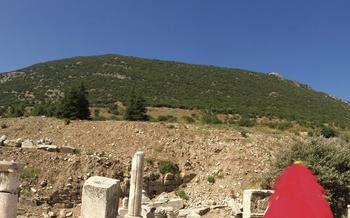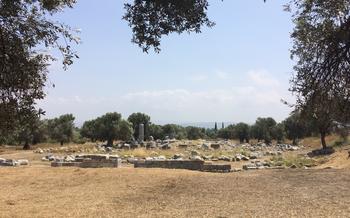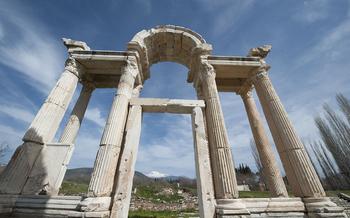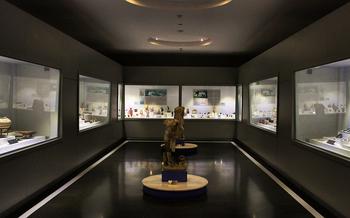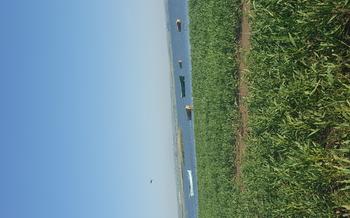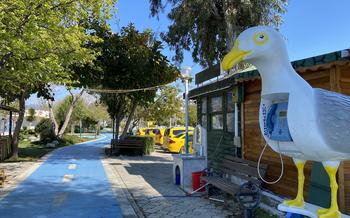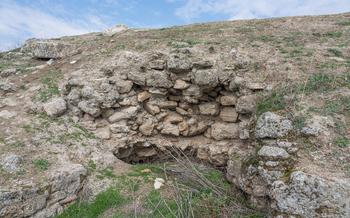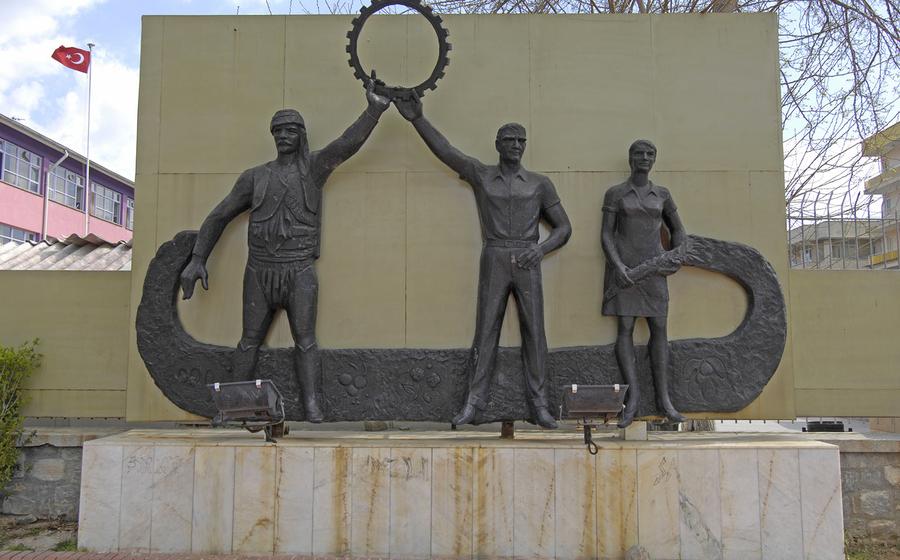
Tralles Ancient City
- Historical Background
- Excavations and Archeological Findings
- Urban Layout and Architecture
- Religious and Cultural Significance
- Tralles' Theatre
- Nymphaion
- Agora
- Temple of Apollo
- Byzantine Period
- Turkish Era
- Modern-Day Tralles
- Visiting the Tralles Ancient City
- Local Cuisine
- Accommodation Options
- Insider Tip: Unveiling Hidden Gems and Unique Experiences
Historical Background
Tralles, an ancient city in Aydın, Turkey, holds significant historical importance. Founded in the 10th century BC by the Carians, Tralles was strategically located at the intersection of trade routes connecting the Aegean coast with the Anatolian hinterland. During the Persian era, the city flourished as a satrapy, contributing to the empire's wealth and power.
With the rise of Alexander the Great in the 4th century BC, Tralles came under Hellenistic rule. Under the influence of Greek culture, the city experienced a period of prosperity and cultural development. It became a prominent center of learning and philosophy, attracting scholars and intellectuals from across the region.
In the 1st century BC, Tralles became part of the Roman Empire. The city continued to prosper under Roman rule, benefiting from the empire's infrastructure and stability. Tralles was granted the status of a free city and became an important administrative and commercial center in the province of Asia.
During the Byzantine era, Tralles remained a significant city, serving as the seat of a bishopric. However, the city's fortunes declined in the late Byzantine period due to wars, invasions, and natural disasters.
Excavations and Archeological Findings
The rediscovery of Tralles dates back to the 19th century when European travelers and archaeologists began to explore the region. Systematic excavations, however, only commenced in the early 20th century, led by German and Turkish teams. These excavations brought to light a wealth of structures, artifacts, and inscriptions, providing invaluable insights into the city's past.
Among the most notable unearthed structures are the theater, the nymphaion, the agora, and the Temple of Apollo. The theater, with its impressive seating capacity and well-preserved stage, stands as a testament to the city's vibrant cultural life. The nymphaion, with its intricate sculptures and reliefs, offers a glimpse into Tralles' religious practices and its reverence for water. The agora, with its colonnaded walkways and surrounding shops, highlights the city's economic importance as a trading center. And the Temple of Apollo, with its imposing columns and finely carved pediments, speaks to the enduring legacy of the Greek god in Tralles.
In addition to these major structures, excavations have also yielded a rich collection of artifacts, including pottery, coins, jewelry, and inscriptions. These artifacts provide valuable information about the city's daily life, economy, and cultural influences. Ongoing research in Tralles continues to uncover new discoveries, shedding further light on this remarkable ancient city.
Urban Layout and Architecture
Tralles' urban plan showcases a well-organized and sophisticated city design. Its streets intersected perpendicularly, creating regular blocks and neighborhoods. The city's main thoroughfare, the "Grand Colonnaded Street," stretched for over 1 kilometer and connected the agora with the city's eastern gate. Along this street, impressive colonnades lined both sides, providing shade and shelter to pedestrians.
The agora, the bustling marketplace and social hub of the city, was located in the center of Tralles. Surrounding the agora were various shops, administrative buildings, and temples. The city's temples, dedicated to deities such as Apollo, Zeus, and Athena, were adorned with intricate sculptures and friezes, reflecting the city's artistic prowess.
Theaters played a crucial role in Tralles' cultural and social life. The city boasted two theaters: a large one with a seating capacity of over 10,000 and a smaller one known as the Odeon. These theaters hosted theatrical performances, musical concerts, and other entertainment events.
Building materials used in Tralles' construction were primarily local stones, such as limestone and marble. The city's architects employed advanced construction techniques, including the use of arches, vaults, and domes. These techniques allowed them to create impressive architectural structures that have withstood the test of time.
Religious and Cultural Significance
Tralles stood as a significant religious center in ancient Ionia, leaving a lasting impact on Greek mythology and religious practices. The city's rich cultural heritage is evident in its impressive temples, theaters, and other sacred structures.
The cult of Apollo held a central position in Tralles' religious life. The city was home to a magnificent Temple of Apollo, which served as a focal point for religious ceremonies and rituals. Apollo, the god of light, music, and prophecy, was revered by the people of Tralles, who believed in his ability to bestow divine inspiration and healing.
Beyond the worship of Apollo, Tralles also played a crucial role in the development of Greek mythology. The city was associated with several mythical figures, including the giant Antaeus, who was said to be the son of Poseidon and Gaia. According to legend, Antaeus drew his strength from contact with the earth, making him invincible as long as his feet remained on the ground.
The cultural influences from neighboring regions and the impact of Hellenization further enriched Tralles' religious and cultural landscape. The city embraced elements from Anatolian, Persian, and Hellenistic cultures, resulting in a diverse and vibrant religious and cultural environment.
Tralles' Theatre
The theater of Tralles is a magnificent spectacle, captivating visitors with its architectural grandeur and historical significance. Constructed during the Hellenistic period, the theater served as a central venue for cultural performances and public gatherings. Its impressive size, accommodating approximately 15,000 spectators, speaks volumes about the city's cultural significance and the importance placed on entertainment and artistic expression.
The theater's design showcases a blend of Greek and Roman architectural influences, harmoniously merging the traditional horseshoe-shaped layout with Roman-style seating arrangements. The stage, adorned with intricate carvings and sculptures, provided a platform for theatrical performances, musical concerts, and religious ceremonies. The acoustics of the theater are remarkable, allowing performers' voices to carry effortlessly throughout the auditorium, creating an immersive and captivating experience for the audience.
Beyond its architectural grandeur, the theater also played a vital role in the social and cultural life of Tralles. It served as a gathering place for citizens from all walks of life, fostering a sense of community and shared cultural experiences. The theater's diverse repertoire included comedies, tragedies, musical performances, and religious dramas, catering to the varied tastes and preferences of the city's inhabitants.
The theater of Tralles stands as a testament to the city's rich cultural heritage and its significant contributions to the performing arts in ancient times. It continues to captivate visitors with its architectural beauty, inviting them to step back in time and experience the vibrant cultural landscape of ancient Tralles.
Nymphaion
The nymphaion, a monumental fountain house, stands as one of the most striking features of Tralles. Constructed in the 2nd century AD, this architectural marvel served as a refreshing oasis and a place of social gathering for the city's inhabitants. Its intricate design and elaborate ornamentation reflect the artistic prowess and cultural significance of ancient Tralles.
The nymphaion's façade is adorned with a series of niches, each housing exquisitely carved statues of nymphs and other mythological figures. These sculptures, with their graceful poses and intricate details, embody the essence of Hellenistic artistry. The fountain's central basin, surrounded by a colonnade, once flowed with fresh water, providing a vital resource for the city's residents.
Beyond its practical function, the nymphaion held deep religious and cultural significance. In ancient Greek mythology, nymphs were revered as minor deities associated with nature and water sources. The presence of these divine figures within the nymphaion created a sacred space, where people could come to pay homage and seek divine favor.
The nymphaion also served as a gathering place for the community. Its spacious interior and shaded colonnade provided a welcome respite from the scorching Mediterranean sun, allowing people to socialize, exchange news, and conduct business. The sound of flowing water and the gentle breeze created a tranquil ambiance, making the nymphaion an ideal spot for relaxation and contemplation.
Today, the nymphaion stands as a testament to the ingenuity and artistry of the ancient Trallians. Its well-preserved remains offer a glimpse into the city's vibrant past and the importance of water in ancient Greek culture. Visitors can still marvel at the intricate carvings, admire the graceful statues, and imagine the lively atmosphere that once filled this sacred space.
Agora
The bustling marketplace of Tralles, known as the agora, played a pivotal role in the city's economy and social interactions. Its central location within the city walls facilitated easy access for residents and visitors alike. The agora's layout was carefully planned, with clearly defined walkways and vendor stalls. Surrounding the marketplace were various structures serving different purposes. Merchants and artisans displayed their wares under covered colonnades, providing shelter from the sun and rain. Within these colonnades, one could find shops selling a diverse array of goods, from locally produced agricultural products to imported luxuries. The agora also housed administrative offices, where officials conducted business and resolved disputes. As the city's commercial hub, the agora was a place where people not only engaged in trade but also exchanged news, ideas, and gossip. It served as a meeting point for merchants, farmers, craftsmen, and ordinary citizens, fostering a sense of community and social cohesion.
Temple of Apollo
The Temple of Apollo, a magnificent edifice dedicated to the revered Greek deity, stands as a testament to Tralles' religious devotion and cultural significance. Constructed in the 2nd century BC, this temple served as a sacred site for the worship of Apollo, the god of music, prophecy, and healing.
The temple's architectural grandeur is evident in its towering columns, intricately carved pediments, and exquisite friezes. Each element of the temple's design reflects the skill and artistry of ancient Greek builders. The columns, adorned with delicate fluting, support an imposing entablature, while the pediments showcase elaborate sculptural compositions depicting scenes from Greek mythology.
Inside the temple, a colossal statue of Apollo once resided, symbolizing the deity's presence and power. This awe-inspiring statue, crafted from precious metals and adorned with intricate details, was a masterpiece of ancient Greek sculpture. Devotees from across the region flocked to the temple to pay homage to Apollo and seek his divine guidance and protection.
The Temple of Apollo played a pivotal role in shaping Tralles' identity as a center of religious and cultural life. Festivals and ceremonies honoring Apollo were held within the temple's sacred precincts, attracting pilgrims and visitors from far and wide. These religious gatherings not only strengthened the community's spiritual bonds but also fostered cultural exchange and intellectual discourse.
Today, the ruins of the Temple of Apollo stand as a poignant reminder of Tralles' glorious past. Although the temple has succumbed to the ravages of time, its architectural splendor and historical significance continue to captivate visitors, offering a glimpse into the rich religious heritage of this ancient city.
Byzantine Period
During the Byzantine era, Tralles underwent significant transformation. As Christianity rose to prominence, the city experienced profound religious and cultural changes. Numerous churches and religious structures were constructed, marking a shift away from the previously dominant pagan beliefs. Tralles also played a vital role in the Byzantine Empire's defense system, serving as a strategic frontier town against external threats. Despite this, the city faced challenges, including invasions and raids, which left their mark on its architectural landscape. Nevertheless, Tralles remained an important cultural and administrative center throughout the Byzantine period, leaving a lasting legacy on the region.
Turkish Era
When the Ottoman Turks expanded their empire into Anatolia, Tralles, like many other ancient cities, fell under their rule. The city's name was changed to Aydın, which it still bears today. During the Ottoman period, Tralles experienced a gradual decline as its former significance waned. The city's infrastructure and buildings underwent some modifications to adapt to the new rulers' needs and preferences. Some Ottoman-era architectural elements, such as mosques and baths, were added to the urban landscape. However, the city's overall character and layout remained largely intact. Over time, Aydın transformed into a small, predominantly agricultural town, losing much of its former grandeur and importance.
Modern-Day Tralles
The ancient city of Tralles has undergone significant transformation over the centuries, transitioning from a bustling metropolis to a humble village during the Ottoman era. Today, as part of modern-day Aydın, Tralles stands as a testament to its rich past, offering visitors a glimpse into its grandeur.
The Turkish government, recognizing the importance of preserving this historical treasure, has undertaken extensive restoration and excavation efforts at the site. As a result, many structures have been unearthed, meticulously restored, and opened to the public. Visitors can now marvel at the well-preserved ruins, including the theater, nymphaion, agora, and Temple of Apollo, which have been brought back to life through careful restoration work.
Tralles' integration into modern-day Aydın has created a unique blend of ancient and contemporary elements. The city's rich history is intertwined with its present-day identity, making it a fascinating destination for travelers seeking to explore the fusion of cultures.
The Archaeological Museum of Aydın, located near the ancient city, houses a treasure trove of artifacts discovered during excavations at Tralles. Visitors can delve deeper into the city's past by examining the impressive collection of sculptures, pottery, coins, and inscriptions that narrate the story of Tralles' glorious days.
As you wander through the ancient city, you'll be struck by the juxtaposition of ancient ruins with modern life. Locals go about their daily lives amidst remnants of a bygone era, creating a vibrant atmosphere that bridges the gap between the past and present. Tralles' integration into modern-day Aydın serves as a reminder of the enduring legacy of this ancient city, continuing to captivate visitors with its timeless charm.
Visiting the Tralles Ancient City
Location, Accessibility, and Entrance Fees
The Tralles Ancient City lies within the modern-day city of Aydın, in southwestern Turkey. It is easily accessible by public transportation, with buses and taxis readily available from the city center. The entrance to the site is located on Cumhuriyet Caddesi, and a modest entrance fee is charged to help with the maintenance and preservation of the ancient city.
Recommended Duration of the Visit and Best Time to Explore
To fully appreciate the grandeur and history of Tralles, it is recommended to set aside at least two to three hours for your visit. The best time to explore the site is during the shoulder seasons (spring and autumn) when the weather is pleasant, and the crowds are smaller. Avoid visiting during the peak summer months (July and August), as the heat can be oppressive.
Facilities Available for Visitors
Tralles Ancient City is well-equipped to accommodate visitors. Guided tours are available in multiple languages, including English, Turkish, and German, providing insights into the city's history and significance. Information centers located at the entrance offer maps, brochures, and additional resources to enhance your exploration. Restrooms and a small cafe are also available on-site for your convenience.
Local Cuisine
When visiting Tralles Ancient City, take the opportunity to savor the delectable flavors of traditional Turkish cuisine. Aydın, where Tralles is situated, offers a rich culinary scene infused with regional specialties and fresh ingredients.
Stroll through the lively streets and discover local restaurants and cafes that serve authentic Turkish dishes. Indulge in the tantalizing aromas of grilled kebabs, succulent yaprak sarma (stuffed vine leaves), and the ever-popular köfte (meatballs). Don't miss out on the chance to try Aydın's signature dish, keşkek, a hearty dish made from wheat, meat, and yogurt.
For a taste of local delicacies, visit the traditional Turkish breakfast places. Enjoy a spread of olives, fresh cheeses, honey, and the ever-present Turkish delight, accompanied by freshly brewed tea.
When in Aydın, don't forget to sample the flavorful mezes (small dishes) that are perfect for sharing. Try the smoky eggplant salad, creamy hummus, or the tangy cacık (yogurt with cucumber and garlic). Pair these with freshly baked pide (Turkish flatbread) for a satisfying meal.
To quench your thirst, sip on a glass of refreshing şerbet, a sweet fruit-flavored beverage, or indulge in a cup of Turkish coffee, a strong and aromatic brew that is a staple of Turkish culture.
For a truly immersive culinary experience, consider taking a cooking class and learning the secrets of Turkish cuisine. Discover the art of preparing traditional dishes using fresh, local ingredients and bring home a taste of Turkey to share with friends and family.
Accommodation Options
When it comes to accommodation in Aydın, you'll find a range of options to suit different preferences and budgets. From modern hotels to cozy guesthouses and charming Airbnb rentals, there's something for every traveler.
For those seeking a luxurious stay, the five-star Aydın Park Hotel offers elegant rooms and suites, a spa, and fine dining options. For a more budget-friendly choice, consider the centrally located Aydın Hotel, which provides comfortable rooms at an affordable price.
If you prefer a more immersive experience, opt for one of the many guesthouses in the old town of Aydın. These traditional houses offer a unique glimpse into local life and culture. Airbnb rentals are another great option for travelers seeking a home away from home, with a wide variety of apartments and houses to choose from.
When selecting your accommodation, consider factors such as location, amenities, and your budget. If you want to be close to the Tralles Ancient City, choose a hotel or guesthouse in the city center. If you're on a tight budget, there are several budget-friendly options available, including hostels and guesthouses.
To find the best deals and discounts on accommodation, book in advance, especially during the peak tourist season. Online booking platforms often offer exclusive discounts and promotions. Local travel agencies can also assist you in finding the best deals and arranging tours and activities.
Insider Tip: Unveiling Hidden Gems and Unique Experiences
Secret Spot: As you wander through the ruins of Tralles, keep an eye out for the hidden "Secret Chamber." Located beneath the main temple complex, this subterranean chamber was once used for religious rituals and ceremonies. Its well-preserved frescoes and inscriptions offer a glimpse into the city's ancient spiritual practices.
Unique Activities: For an unforgettable experience, time your visit to Tralles during the annual "Tralles Festival." This vibrant festival brings the ancient city to life with traditional music, dance performances, and historical reenactments, allowing you to immerse yourself in the spirit of the past.
Combine and Conquer: To make the most of your trip, consider combining your visit to Tralles with a visit to the nearby ancient city of Ephesus. Located just 30 kilometers away, Ephesus is one of Turkey's most iconic archaeological sites, boasting impressive ruins, including the Library of Celsus and the Great Theater.
